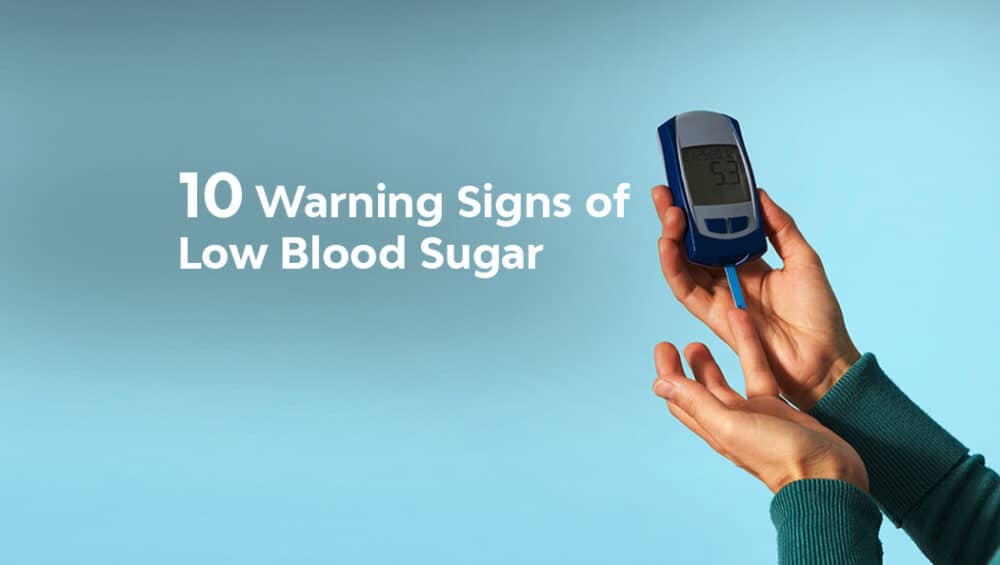10 Warning Signs of Low Blood Sugar
Feeling shaky and weak, or experiencing sweating, heart palpitations, or difficulty concentrating when you’re not hungry? You may be experiencing a sign of low blood sugar symptoms. The decrease in blood sugar levels is a critical medical condition. Learn the warning signs of low blood sugar and what you should do if symptoms occur. In this article, you’ll learn ten warning signs of low blood sugar that you should be aware of. Read on to find out more.
What Is Diabetes?
Diabetes is a chronic condition that occurs when the body cannot produce enough insulin or is unable to properly use the insulin it produces. This can lead to high blood sugar levels, which can damage various organs in the body over time. Symptoms of diabetes include increased thirst and urination, fatigue, blurred vision, and slow-healing wounds. In some cases, people with diabetes may experience low blood sugar levels (hypoglycemia), which can cause low blood sugar symptoms such as dizziness, sweating, and confusion. If left untreated, diabetes can lead to serious health complications such as heart disease, stroke, kidney disease, and nerve damage.
Types Of Diabetes
Type 1 and Type 2 are the main types of diabetes.
The insulin-producing beta cells of the pancreas are attacked and destroyed in type 1 diabetes, an autoimmune illness. This type of diabetes usually develops in childhood or adolescence but can occur in adults as well.
Type 2 diabetes is a metabolic disorder that is characterized by high levels of blood sugar (glucose). This type of diabetes typically develops in adulthood, but can also occur in children and adolescents.
Read Also : How to Reduce Stress & Anxiety Naturally
Home Remedies For Diabetes
If you have diabetes, you know how important it is to keep your blood sugar levels under control. But sometimes, despite your best efforts, your blood sugar levels can drop too low. This can lead to the signs of low blood sugar symptoms.
Low blood sugar is called hypoglycemia, and it can be a serious problem if not treated quickly. That’s why it’s important to know the warning signs of low blood sugar symptoms and what to do if you experience them.
The most common symptom of low blood sugar is feeling shaky or dizzy. You may also feel sweaty, hungry, or have a rapid heartbeat. If your blood sugar level drops too low, you may even lose consciousness.
If you experience any of these low blood sugar symptoms, it’s important to raise your blood sugar level right away by eating or drinking something that contains sugar. Fruit juice, regular soda, candy, and table sugar are all good options. Once your blood sugar level has returned to normal, be sure to eat a meal or snack so that it doesn’t drop again.
If you have diabetes and frequently experience low blood sugar levels despite taking steps to prevent them, be sure to talk to your doctor. You may need to adjust your medication or make changes to your diet
10 Warning Signs of Low Blood Sugar
There are several warning signs of low blood sugar, or hypoglycemia, that you should be aware of. These include feeling shaky or trembling, sweating, heart racing, hunger, and dizziness or lightheadedness. If you experience any of these symptoms, it’s important to check your blood sugar levels right away and take steps to raise them if necessary. Let us check on the warning signs of low blood sugar symptoms:
1. Sleep disturbances
Around a majority percent of low blood sugar levels are caused due to nocturnal hypoglycemia and this is the main cause of different sleep disturbances. The symptoms of these sleep disturbances include sweating during sleep, nightmares, waking up from sleep suddenly, and disorientation when you wake up. This sign of low blood sugar symptoms can also be decreased by eating a snack before bed. The appropriate blood sugar of an individual is between 90 and 150 mg/dL before rest.
2. Sweating
One of the main signs of low blood sugar symptoms is sweating and which is caused due to adrenaline, which boosts the glucose level drops(According to an article in Practical Diabetes, 2017). When individuals affected with diabetes are hypoglycemic (a condition in which an individual’s blood sugar level is lesser than the standard range), the chances of sweating is more compared to others and mostly the back of your neck gets more sweating. This changes when you suddenly have some sugar and more care is needed in these situations to avoid further health problems.
3. Ravenous Hunger
Your body is indicating that a blood sugar drop is taking place if you suddenly, unexplainably feel like you’re starving. The key thing to controlling your blood sugar levels is by managing the carbohydrate intake in your body. The standard recommended rate of carbohydrate intake for an individual is between 15-20g during eating a snack and 40-65g during each meal. But this may vary according to each individual and it is always better to consult a dietitian or certified diabetes care & education specialist to understand the carbohydrate intake you require.
4. Tremors and Shakes
When the autonomic nervous system activates during hypoglycemia, it leads to shakiness symptoms and is also one of the signs of low blood sugar levels symptoms.
5. Emotional Instability
The neurological symptoms of hypoglycemia can lead to mood swings and sudden changes in emotions which are not common in normal individuals. This sign of low blood sugar symptoms also causes irritability, depression, and stubbornness, which completely affects the mental health of an individual.
Read Also : Top 5 Ayurvedic Immunity Boosters for 2023
6. Lightheadedness
This feeling of lightheadedness is a low blood sugar symptom caused when the brain tries to store as much energy as it can store, as the blood sugar is low. The best way to treat this hypoglycemia is to consume 15 to 20g of fast-acting carbs, such as juice to get relief from this lightheadedness. Have some rest for 15 minutes after this, and if the symptom is still there, it is better to seek medical help.
7. Feelings of Anxiety
As a result of the lowering in blood sugar levels, the body secretes hormones known as epinephrine (also called adrenaline) and cortisol. These hormones then signal the liver to impart more sugar into the blood leading to anxiety and related symptoms such as sweating, heart palpitations, and shakiness. This low blood symptom also affects the mental health of an individual directly.
8. Eyesight issues
Vision issues of the eyes are one of the major low blood sugar symptoms that have been proven by studies. A decrease in blood sugar levels also caused blurred vision, dimness in vision, or black spots.
9. Slurred Speech and clumsiness
Your voice can change because of the lack of sugar. Slurred speech is a common symptom associated with blood sugar levels below 40 mg/dL. Even if you haven’t drunk a drop of alcohol, you could appear to have had a few too many cocktails when combined with clumsiness, another indicator of low blood sugar.
10. Difficulty in concentrating
The brain consumes energy mainly from blood sugar, so the decrease in glucose may directly affect the brain and makes it difficult to concentrate on a particular thing. This leads to a lack of concentration on one particular thing at a time. The good news is that moderate hypoglycemia episodes don’t seem to cause permanent brain damage.
Final WordsRead Also : How to Boost Your Immune System ?
There are several ways to control diabetes naturally. The most crucial thing is to keep up a healthy diet. Consuming a lot of fruits, vegetables, and whole grains is necessary. Along with this, avoid processed foods, sugary drinks, and excessive amounts of saturated fat. Exercise is another key component of diabetes control. Having at least 30 minutes of moderate exercise each day can help to improve insulin sensitivity and avoid low blood sugar symptoms. For patients with high blood sugar levels, considering solutions like Dhathri Diavita Plus, specifically created to support diabetes management, could offer valuable help in their journey towards better health.
Finally, it is important to monitor blood sugar levels regularly and take steps to keep them within a healthy range. This may involve making adjustments to diet and exercise, as well as taking medication if necessary.



















